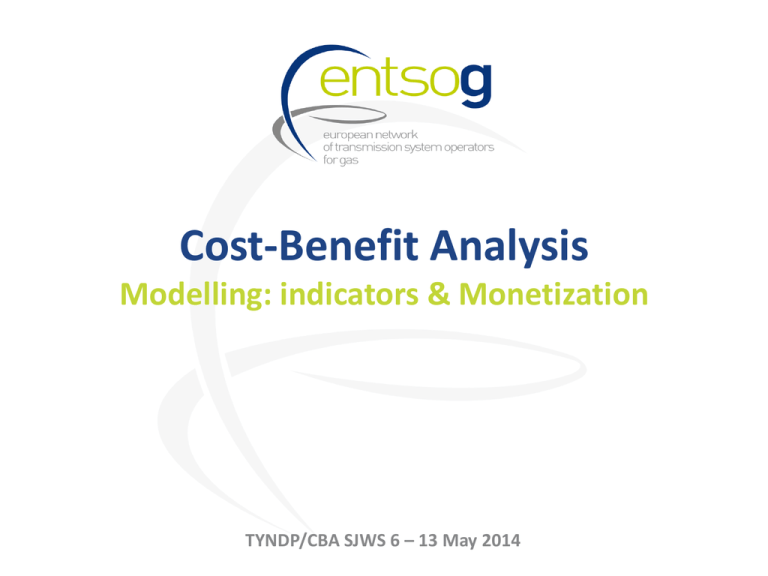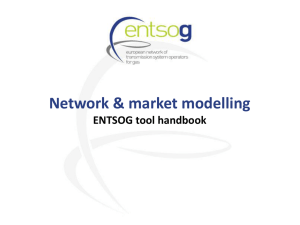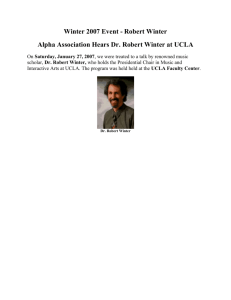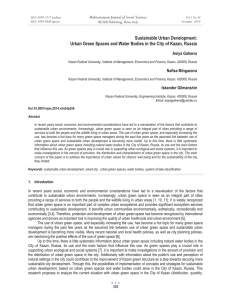Cost-Benefit Analysis (Modelling:indicators and
advertisement

Cost-Benefit Analysis Modelling: indicators & Monetization TYNDP/CBA SJWS 6 – 13 May 2014 To go beyond direct impact of the project The definition of flows > Modelling enables a more thorough assessment of the European gas system as considering simultaneously both supply and capacity constraints > Flow pattern resulting from modelling can be analysed from both a quantitative and qualitative perspective > Nevertheless the defined flow patterns are not to be seen as a forecast The incremental approach applied to modelling > Under a given level of development of gas infrastructure and a set of assumptions defining supply and demand, the modelling tool defines the flow pattern: a) Balancing the demand of every node b) Keeping flow within capacity and supply constraints c) Minimizing the objective function considering gas supply, coal and CO2 costs > The capacity increment of the project releases the constraint b) this can result in a flow pattern minimizing further the objective function 2 Example of indirect benefit Situation before the project Situation with the project Improvement of the supply component of the objective function > The project has enabled a further spread and higher use of the cheapest source Before the project: 60 x 20 + 90 x 24 = 3360 € After the project: 75 x 20 + 75 x 24 = 3300 € Project benefit: 60 € > Capacity-based indicators would not have been able to identify benefit in country in light blue 3 The modelling approach to monetization -1 1 year split into 4 differently long-lasting periods Source 1 Source 1 Summer Source 2 Summer A B C Source 2 Source 1 Winter Source 2 Winter A B Source 1 DC Source 2 DC A C B Source 1 2W Source 2 2W A B C C Period 1 Summer average Period 2 Winter average Period 3 Design Case Period 4 2Week peak 183 days 167 days 1 day 14 days Total Winter: 182 days 4 Temporal optimization of the year 1 year split into 4 differently long-lasting periods Source 1 Source 1 Summer Source 1 Winter Source 1 2W Source 1 DC Summer Winter 2W DC One Supply curve per source – different price levels in the different periods given by the different demand levels. Different flow constraints will define the potential range for each period. 5 Modelling of seasons are interlinked 1 year split into 4 differently long-lasting periods Source 1 Source 1 Summer Source 2 Summer A Source 1 Winter Source 2 Winter A B C AS Source 2 Source 1 DC A B C AW UGS A Source 1 2W Source 2 2W A B B C C DC UGS B Source 2 DC 2W The link between the different periods is given by the use of UGS. 6 Gas flow from season to the other through UGS 1 year split into 4 differently long-lasting periods Source 1 Source 1 Summer Source 2 Summer A Source 1 Winter Source 2 Winter A B C AS Source 2 Source 1 DC A B C AW Source 2 DC Source 1 2W A B B C C DC Source 2 2W 2W The source 2 stored in UGS A during Summer reach A and then C during the Winter Source 2 reaching directly node A during summer UGS A UGS B The different demand levels in the different cases derive in different flow patterns. 7 The monetized layers Costs follow the flow pattern • The model minimizes the total costs for Europe (“Total EU bill”) • The Total EU bill includes: • Supply costs: • Import costs Cs • National production CIP • Coal costs • CO2 costs CC • CO2 from coal • CO2 from gas • CEc CEg Infrastructure costs: • UGS costs (injection + withdraw) Cu • LNG infrastructures costs • Transportation costs Ct CL A change in the definition of the supply curves or in the unitary costs would involve a change in the resulting flow patterns and Total EU bill. 8 Where costs are measured - 1 Cs Cost of gas supply: Imports Ct Cost of transport Cu Cost of UGS Source 1 LNG Cs Cs Source 2 Summer Cs Cs Cs Source 1 Summer CL Cost of LNG infrastructures Source 2 Cs Cs Source 1 Winter Cs Source 2 Winter Source 1 DC CL CL A Ct C Ct Ct AW Cu Cu Cu UGS A UGS B DC Cu B Ct Ct Ct C C Cu Cu A B Ct Ct C Cu AS A B Source 2 2W CL CL A B Source 1 2W Source 2 DC 2W Cu The resulting flow pattern minimizes the total cost for the system. 9 Where costs are measured - 2 Cs Cost of gas supply: Imports CIP Cost of gas supply: Indigenous/National production Source 1 LNG Cs Cs Source 2 Summer Cu Cost of UGS CL Cost of LNG infrastructures Cs Cs CIPs Source 1 Summer Ct Cost of transport Source 2 Indigenous Source 2 prod. CIPs CIPs CCIPs Source 1 Winter Source 2 Winter Source 1 DC CL CL A Ct C Ct Ct AW Cu Cu Cu UGS A UGS B DC Cu B Ct Ct Ct C C Cu Cu A B Ct Ct C Cu AS A B Source 2 2W CL CL A B Source 1 2W Source 2 DC 2W Cu The resulting flow pattern minimizes the total cost for the system. 10 Focus on power generation Cs Cost of gas supply: Imports CIP Cost of gas supply: Indigenous/National production Coal Ct Cost of transport CEc Cu Cost of UGS CC CL Cost of LNG infrastructures CC Cost of coal supply Electricity node A CEc CEg Cost of emissions from Coal Cost of emissions from Gas CEg Gas demand 11 An actual example Addition of a project: change in flow patterns 4 1919 478 4 1340 1340 64 64 122 33 7,6 634 68 133 17 685 122 33 17 58 29 188 218 1919 478 216 654 56 94 188 36 688 24 17 46 36 27 39 475 475 288 288 873 873 FID Example: Reference case, Green Scenario, Winter average day FID + LNG HR Addition of a project: change in the European bill FID FID+LNGHR 12 Split of European bill per country From European level to country one > The change in objective function resulting from the project implementation provides directly the monetization of project benefits at EU level > The methodology to split such benefits per country is still under testing > The comparison of benefits and investment cost per country will provide the net impact for each country Form of the results > For each scenario and case, the TYNDP-step will provide the following table: Bn € 2015 2020 2025 2030 2035 Country A 200 210 215 220 215 Country B 100 101 102 103 104 150 150 140 150 155 … Country Z > PS-step will result in the same table, which once compared with the TYNDP-step one will provide the incremental benefit per country 13 Example of calculation 14 Remaining Flexibility The ability of a country to meet additional demand > This indicator introduced in TYNDP 2010-2019 intends to measure the ability for a country to meet additional demand under: Peak situation Supply stress situation Evolution of the indicators calculation > Historic formula was overestimating the flexibility: 𝐸𝑛𝑡𝑟𝑖𝑛𝑔 𝑓𝑙𝑜𝑤𝑠 1− 𝐸𝑛𝑡𝑟𝑦 𝑐𝑎𝑝𝑎𝑐𝑖𝑡𝑦 No consideration of upstream capacity or supply limitation Erroneous consideration of bi-directional interconnection > A new calculation closer has been defined, closer to the meaning of the indicator Europe is modelled with an alternative increase of the demand in each country, the maximum relative increase of demand defines the Remaining Flexibility 15 Remaining Flexibility – UGS Kavala Application > Modelling of Ukraine disruption under 1-day Design Case peak TYNDP-step Low Infra. Scenario High Infra. Scenario PS-step Low Infra. Scenario + project High Infra. Scenario - project Project impact under Low Infra. Scenario +9% R. Flex in GR +5% of demand cover in BG High Infra. Scenario Beyond indicator range 16 Price convergence The relative move of the price of 2 zones > This indicator is based on the marginal price of each zone being the price of the additional supply that would be required to serve one unit more of demand in that zone > The implementation of a project can result in: Spatial convergence, being 2 countries under a given climatic case see their marginal prices becoming closer Temporal convergence, being one country having its winter and summer marginal prices becoming closer € Dem Dem Marginal price Q 17 Price convergence – UGS South Kavala & GIPL UGS Kavala compared to Low Infra. scenario GIPL compared to High Infra. scenario Supply Source Dependence Identification of countries highly dependent on a single source > Assessment carried out through out the year under the minimization of the source on which dependence is investigated > As for other indicators, within a given region, the relative dependence of one country compared to the other may change according actual repartition Supply Source Diversification Should it be about physical access or “contractual one” > The first is based on supply shares defined by the flow pattern resulting from modelling > The second is more related to the ability of a country to benefit from a decrease of its marginal price resulting from a project implementation (this could happen without physical access) 19 Thank You for Your Attention Olivier Lebois Business Area Manager, System Development ENTSOG -- European Network of Transmission System Operators for Gas Avenue de Cortenbergh 100, B-1000 Brussels EML: olivier.Lebois@entsog.eu WWW: www.entsog.eu








